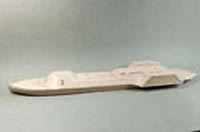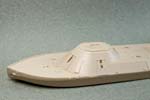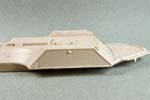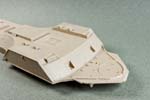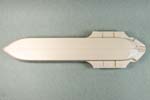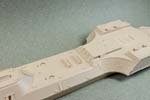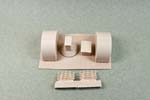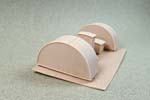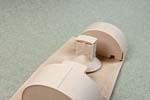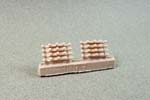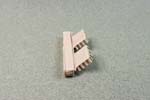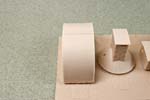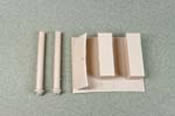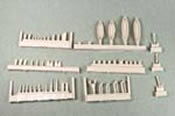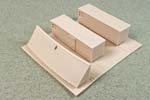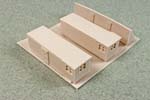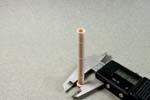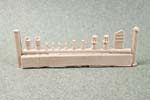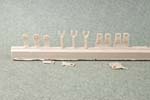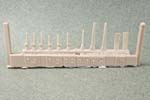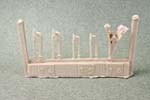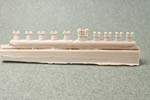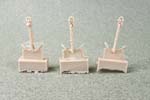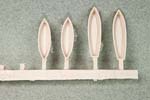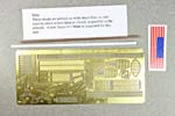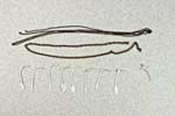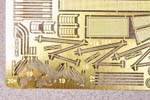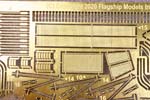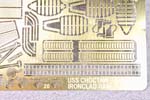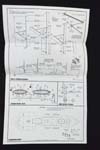USS CHOCTAW
Ironclad Ram

Flagship Models. 1/192nd scale. Resin
Reviewed by Devin Poore, June 2021
Choctaw was laid down and launched during 1855 in New Albany, Indiana, as a cargo and passenger steamer. Known for her cargo capacity and speed, she was one of the most sought-after transports for the lucrative cotton trade. She mostly ran the St. Louis to New Orleans route, until running aground and sinking in 1860. Raised and back in service later that year, she continued to operate until the initial secession of southern states in 1861, shortly after which her captain was arrested on grounds of treason, upon reports that he intended to deliver Choctaw to Confederate authorities. Seized by the U.S. Marshall service, she was purchased by the War Department in late 1862.
Commander William D. Porter converted several civilian steamers to Union ironclads, Choctaw included. Originally conceived as armored from bow to stern, with India rubber sheeting under the iron for added protection, memos from the time of her construction suggest removing large amounts of the armor for weight considerations; weight was the major concern with Choctaw and all of the other ironclad conversions. The main guns were to be placed in a forward fixed turret, with an interior rotating gun platform; the fixed gun turret or "citadel" was retained, but the rotating platform was dropped, again, due to weight considerations. Choctaw's engines and boilers were moved lower in the hull to below the waterline for added protection, but the commercial engines were retained, so that with all of the extra weight of armor and armament, Choctaw's maximum speed was 2 knots against the current, 4 knots with. Another unique design feature was her iron bow ram. Her slow speed made such a device useless, however, and the only ship it ever struck was the tug Lilly, who, while attending an anchored Choctaw, was carried by the current onto the iron beak, breached, and sank immediately.
Choctaw entered service in April 1863, serving on the Mississippi River and its major tributaries. She saw battle at Drumgould's Bluff, the burning of the Yazoo City Navy Yard, Milliken's Bend, the siege of Vicksburg, the Red River expedition, and continuous river patrols. Overweight and slow, Choctaw nevertheless proved a very stable gun platform, able to absorb punishment. Stuck dozens of times during the war, with up to ten-inch projectiles, her armor was penetrated several times, yet she never lost a crewman to enemy fire. Decommissioned in July 1865, she was sold for her scrap value of just under $10,000 in April of 1866.
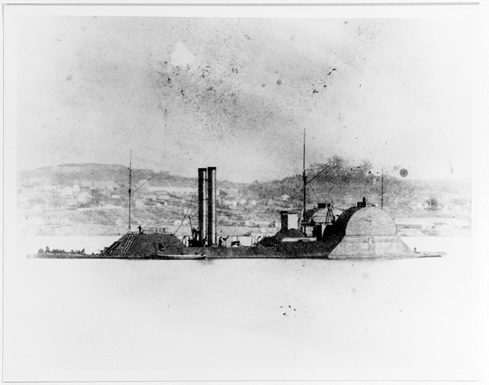
The USS Choctaw kit marks a first for Flagship Models: A CAD designed and 3D printed hull master. The result is a very clean and sharp hull casting in solid resin. My copy has a few areas where bits of the mold have flaked off and left resin blobs in a couple of spots, and some major clean-up will be required at the casting pour gate on the stern, but these are the only real issues. Detail on the hull is sharp and clean: deck planking is finely scribed, as are the plates that make up the armor plating. The kit has raised bolt heads on the armor around the forward oval casemate, along the main deck sides, and on the paddle wheel guards. Depending on what accounts you read, she may have had the armor plating removed from everywhere but the forward gun casemate - she was so heavy and slow they tried everything to lighten her. If the builder decides to go that route, it's an easy modification to sand off the bolt heads. This being a 3D printed master, there are very fine layer lines visible at certain points on the casemate. These will hopefully disappear under a coat or two of primer.
For sizing, Choctaw is listed in The Old Steam Navy (the definitive reference for Union ironclads) as 270 feet long, including her ram. The kit's hull measures out to 15 1/4" overall, including the ram, which is nearly 1 1/2" short in scale. Hull width at the paddle wheel housings was 69 feet (not the 45 feet listed on Wikipedia, that measurement was without her paddle guards), which should be 4 1/3" in 1/192nd scale, with the model's hull measuring 3 3/4" at the widest point. Overall, then the hull is a bit on the small side for 1/192nd scale, but it doesn't affect the look of the ship at all.
A large casting wafer has the tops for the two paddle wheel guards, the armored pilot house, and what's often referred to as the "kitchen" or cooking structure. The parts are well raised off of the casting block, so removal and flush sanding should be straight forward. The bolt detail on the pilot house is well rendered, as is the window detail on the kitchen. A nice touch is that the numbers for the parts are embossed on the casting wafer, which match up to the parts list in the instructions.
Also included in the bag with the paddle housings are the paddles themselves. These are the radial arms and just a hint of the outermost layer of the wheel. The paddles, or buckets, are to be cut from the provided .040 x .100 styrene strip.
Another large casting block contains three structures: the port and starboard officer's quarters, and a piece listed as the "aft bulkhead". The officer's quarters have nice window and door detail, with a corresponding location marked by indentations on the hull. The piece marked "aft bulkhead" is one of those "did she or didn't she?" Choctaw questions that will likely never be answered. This structure looks different on various plans and drawings, and it's located immediately between the paddle housings, so photos of the ship don't show it. Regardless, the piece in the kit is well detailed, and no one will be able to definitively tell you it isn't correct.
Three other major details are the ships stacks, referred to as chimneys at the time, anchors, and the ship's boats. The stacks have nice recessed seams, raised banding, are are hollow at the top. The anchors do have a lot of flash, but it's very fine, and should clean up easily. The ship's boats look great, very nicely cast with flooring detail. Seats and oars are provided on the photo etch sheet and should make these look quite nice.
Other small details in resin include well-rendered capstans, the ship's rudder, and ventilation cowlings that, while not completely hollow, do have convincingly deep openings. Gun barrels are provided, as are bitts and chocks. Parts for the mast assemblies include Fife rings, mast caps, and other resin bits that combine with the provided wooden dowels to be assembled from the detailed instructions.
The photo etched brass sets are where the Flagship Models Civil War kit have always excelled. Here is no exception. The stanchions, boat oars, ladders, anchor davits, etc. that you find on all of the sets are included here. Ship-specific pieces such as the grating around the paddle housing observation decks, boat interiors, and other parts make this set unique to Choctaw.
Other metal items include two sizes of chain, the heavier for the anchors, the lighter for the anti-hog bracing that runs the length of the ship. Differing from other Flagship kits, the boat davits are included in white metal, rather than the typical photo etched pieces. I have to admit just a bit of disappointment with this, as I'm a huge fan of Flagship's boat davits: very fine and deceptively strong. I'll just raid my spare etch sheets if I feel the need.
The remaining parts that make up the kit are are the aforementioned styrene stock for the paddle buckets, two sections of wooden dowel -- looks to be walnut -- for the masts, and a decal for the ship's flag.
The instructions are on two legal sized sheets of paper, one of them double-sided. The bulk of assembly is shown in a single overhead perspective shot, showing the individual components with part numbers that correspond to an inventory diagram, annotating where they go in their corresponding slots, holes or recesses on the hull. Larger, exploded view drawings covering assembly of the ship's boats and mast assemblies take up most of the second page, as these pieces require a bit more description. There honesty aren't many steps to the construction process, but while the model overall is a bit larger than a 1/350th scale WWII destroyer, there aren't nearly as many parts, so the simplified nature of these directions should work just fine.
One interesting item on the instructions is a depiction of a hard-mounted Gatling gun, with the annotation "Make Gatling Guns from Scrap". That's an intricate little assembly to make from scrap, but I'm glad they called it out as a suggestion, as I think it'll be fun to make one with a bit of 3D printing and some Albion brass tubing.
This kit is a winner. There are some issues, to be sure: the hull is a little undersized, the casting block on the stern is going to take some careful work with a grinding tool and/or razor saw to shape properly, but those are the biggest issues. The print layer lines are another area of concern, but with the complexity of the hull, there's no real way around it, and the lines are fine enough that a good primer coat should fill them. I've been critical of the Flagship Models kits in the past, but all of the issue I've had will those kits, such as old masters for the hulls, old molds for the small parts such as the ship's boats, etc., all have been rectified in the USS Choctaw offering. It looks as if it'll assemble easily enough, and result in a great looking model.
Highly recommended for U.S. Civil War aficionados, and those who love weird looking ships.
The Flagship Models USS Choctaw kit retails for $170, and can be purchased directly from the Flagship Models' website. Thank you to Flagship Models for the review sample.
References:
Walker, David A. USS Choctaw: Well Adapted to the River Service, "Civil War Navy - The Magazine", Spring 2020.
Canney, Donald L. The Old Steam Navy: The Ironclads, 1842-1885, Naval Institute Press, 1993.
Meagher, David. USS Choctaw plan set.
